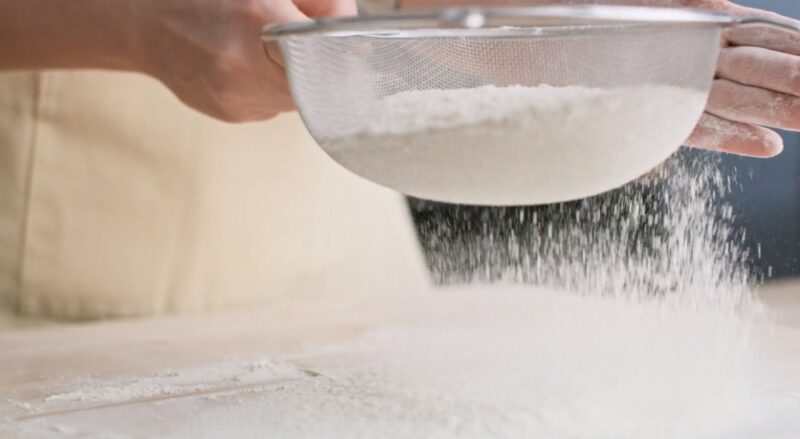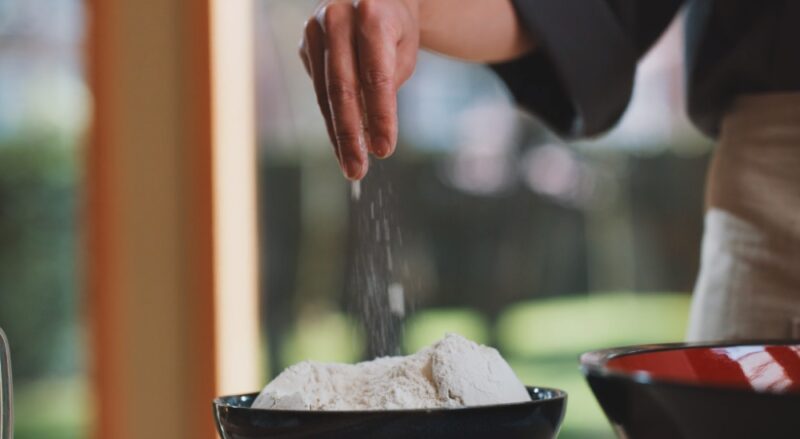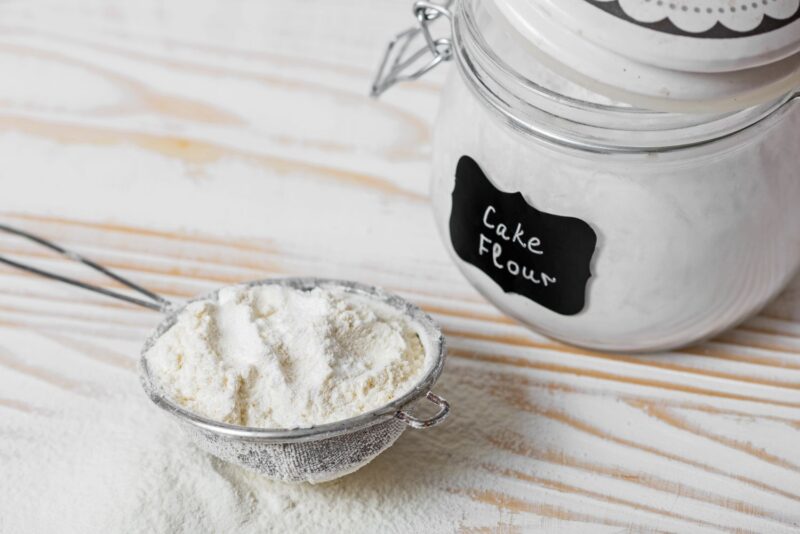Cake flour is a cornerstone ingredient in the world of baking, renowned for its capacity to produce cakes with a light, airy texture. Unlike all-purpose flour, which is often used in a variety of recipes, cake flour is specifically designed for cakes with a lower protein content, resulting in less gluten development.
This unique characteristic makes it a must-have for anyone serious about baking. This guide aims to demystify the process of making cake flour, ensuring that even those new to baking can achieve professional-level results in their home kitchens.
Making Cake Flour at Home
Creating this flour at home is surprisingly straightforward and requires only two common kitchen staples: all-purpose flour and cornstarch.
Ingredients and Tools

- All-purpose flour: This will serve as the base for your cake flour.
- Cornstarch: A pure starch, cornstarch is used to reduce the protein content in your mixture, aiding in achieving that tender cake crumb.
- Sifter or fine mesh strainer: This tool is essential for combining the flour and cornstarch thoroughly and adding air to the mixture.
- Spoon and Measuring Cup: For accurate measurement, which is critical in baking.
Step-by-Step Guide

- Measure the Flour: Begin by scooping one cup of all-purpose flour. This amount is a good starting point for most cake recipes.
- Remove Two Tablespoons: From this cup, remove two tablespoons of flour. This reduction helps lower the overall protein content, making it closer to that of commercial cake flour.
- Add Cornstarch: Add two tablespoons of cornstarch to the flour. The cornstarch, being gluten-free, dilutes the protein content while contributing to the soft, tender texture you want in cakes.
- Sift Together: Sift the flour and cornstarch mixture to ensure they are well combined. Sifting not only mixes these ingredients uniformly but also aerates the flour, making it lighter and closer in texture to store-bought cake flour.
- Repeat for Larger Quantities: If your recipe requires more than one cup of cake flour, simply repeat this process for each additional cup.
This homemade cake flour can be directly substituted in any recipe that calls for commercial cake flour. The process is easy, and efficient, and yields a product that significantly enhances the texture of your baked goods.
Tips for Best Results

Sift Multiple Times
For an even finer texture, sift the mixture several times. This extra step incorporates more air into the flour, bringing its texture closer to that of commercially milled cake flour.
Proper Storage
If you make a large batch, be sure to store your homemade cake flour in an airtight container in a cool, dry place. It can remain fresh and usable for several months.
Precise Measurement
Baking is often described as a science, and accuracy in measurement is a key part of that. Use a spoon to gently fill your measuring cup with flour, then level it off with a knife for the most precise measurement.
Adjusting Recipes

Integrating homemade cake flour into your recipes requires some understanding of how it might alter the baking process. Although a fantastic substitute for store-bought cake flour, homemade versions may necessitate slight adjustments to ensure your cakes turn out perfectly every time.
Homemade cake flour might interact differently with moisture compared to commercial cake flour. Therefore, you might need to slightly tweak the amount of liquid ingredients in your recipe to achieve the right batter consistency.
Leavening Agents
The reaction of homemade cake flour with leavening agents like baking powder or soda could vary due to the altered protein content. It’s important to observe how your batter behaves, especially in terms of rising, and make adjustments in future baking endeavors as needed.
Mixing and Handling
One of the key factors in achieving a tender cake texture is avoiding over-mixing, which can develop gluten even in lower-protein flours. It’s crucial to mix your batter just enough to combine the ingredients, thus preserving the light and tender crumb that cake flour is known for.
Experiment and Take Notes
Remember, baking is both an art and a science. When using homemade cake flour, feel free to experiment with your recipes. Keep a baking journal to note any adjustments you make and their effects on the final product.
This practice will help you refine your recipes and techniques over time, leading to consistently better results.
Why Not Just Use All-Purpose Flour?
While all-purpose flour is a great all-rounder in the kitchen, it doesn’t always yield the best results for cake baking. Its higher protein content can lead to a denser cake, which might not be desirable for certain types of cakes that require a delicate, airy texture.
Although all-purpose flour is more readily available and often less expensive than cake flour, the difference in the final baked product is noticeable. For those seeking to achieve a professional bakery-like texture in their cakes, the switch to cake flour is well worth it.
However, since cake flour isn’t always readily available in every grocery store, knowing how to make it at home becomes an invaluable skill for any baker.
Creative Uses and Recipes

Armed with your homemade cake flour, you’re now ready to explore a range of baking possibilities. Here are some innovative ways to use this ingredient, along with detailed recipes to try.
- Pancakes: Use cake flour instead of all-purpose flour for pancakes that are exceptionally light and fluffy. The fine texture of the flour contributes to a delicate, melt-in-your-mouth experience.
- Cookies: When baking cookies that benefit from a tender texture, such as shortbread or sugar cookies, substituting all-purpose flour with cake flour can make a notable difference.
- Cupcakes: Cupcakes made with cake flour will have a finer, softer crumb. This makes them ideal for special occasions where you want a touch of elegance and delicacy.
Recipes to Try
Classic Vanilla Cake
| Ingredients | Method |
|---|---|
| 2 cups homemade cake flour | 1. Cream together butter and sugar until light and fluffy. |
| 1 cup sugar | 2. Add eggs one at a time, mixing well after each addition. |
| ¾ cup butter | 3. Combine your homemade cake flour with baking powder and add to the mixture alternately with milk, starting and ending with flour. |
| 4 eggs | 4. Stir in vanilla extract. |
| ¼ cup milk | 5. Bake in a preheated oven at 350°F (175°C) for about 25-30 minutes. |
| 2 tsp baking powder | |
| 1 tsp vanilla extract |
Red Velvet Cupcakes
| Ingredients | Method |
|---|---|
| 1 ½ cups homemade cake flour | 1. Cream butter and sugar. |
| 1 cup sugar | 2. Add eggs and mix well. |
| ½ cup butter | 3. Mix in cocoa and red food coloring. |
| 2 eggs | 4. Combine homemade cake flour with baking soda. |
| 2 tbsp cocoa powder | 5. Add flour mixture to the batter alternately with buttermilk. |
| 1 cup buttermilk | 6. Stir in vinegar. |
| 1 tsp vinegar | 7. Pour into cupcake liners. |
| 1 tsp baking soda | 8. Bake at 350°F (175°C) for 20-25 minutes. |
| Red food coloring |
Lemon Pound Cake
| Ingredients | Method |
|---|---|
| 3 cups homemade cake flour | Cream butter and sugar. |
| 2 cups sugar | Add eggs one at a time. |
| 1 cup butter | Combine homemade cake flour with baking powder and lemon zest. |
| 5 eggs | Add to the batter alternately with buttermilk and lemon juice. |
| 1 cup buttermilk | Pour into a greased loaf pan. |
| Zest of 1 lemon | Bake at 325°F (165°C) for about 60 minutes. |
FAQs
Can I use whole wheat flour instead of all-purpose flour to make cake flour?
It’s not recommended. Whole wheat flour has a higher protein content and a different texture due to the bran and germ. This can lead to denser and heavier cakes, which contradicts the purpose of using cake flour for a lighter, finer crumb.
Does homemade cake flour have a different shelf life?
Yes, the shelf life can differ. Since it’s a mixture of all-purpose flour and cornstarch, its shelf life will typically align with the shortest shelf life of these two ingredients. Generally, it’s safe to use within 6-8 months if stored properly in a cool, dry place.
Can I use gluten-free all-purpose flour to make gluten-free cake flour?
Yes, you can use gluten-free all-purpose flour combined with cornstarch to make a gluten-free version of this flour. The proportions remain the same, but keep in mind that the texture and taste might vary slightly from traditional cake flour due to the different compositions of gluten-free flour.
Is there a difference in the baking temperature or time when using homemade cake flour?
Generally, the baking temperature and time remain the same. However, since homemade cake flour can affect the moisture and texture of the batter, it’s always good practice to check your bake a few minutes earlier than the recipe suggests, just to ensure it’s not overbaking.
Can I use rice flour or potato starch instead of cornstarch when making cake flour?
Yes, you can substitute cornstarch with rice flour or potato starch. Both are gluten-free and can help reduce the protein content of all-purpose flour. The texture might vary slightly, so it’s worth experimenting to see which substitute works best for your specific recipe.
If I’m making a chocolate cake, should I adjust the amount of cake flour used?
When making a chocolate cake, you might need to adjust the flour quantity slightly, especially if the recipe calls for a significant amount of cocoa powder.
Cocoa powder can act similarly to flour, so reducing the flour by a tablespoon or two, depending on the amount of cocoa in the recipe, can help maintain the desired cake texture.
Conclusion
Making cake flour at home is not only simple but also a game-changer in the world of baking. It allows you to achieve professional-quality cakes with a light, tender crumb and opens up a world of culinary creativity.
By following the tips and recipes provided, you can master the art of using homemade cake flour, ensuring your baked goods are always a hit. Remember, the beauty of baking lies in the joy of experimentation and the satisfaction of sharing your creations with others. Happy baking!
